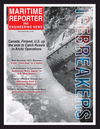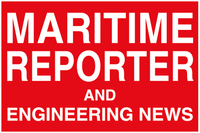
Page 12: of Maritime Reporter Magazine (November 2025)
Read this page in Pdf, Flash or Html5 edition of November 2025 Maritime Reporter Magazine
Digitalization
FROM RAW TO REAL-TIME: Engineering Big
Data for Maritime Logistics Resilience
By Capt Gajanan Karanjikar or most operators, “visibility” once meant knowing that AI could reduce CO emissions by up to 47 million tonnes 2 where the ship last pinged on AIS and when the next annually by optimizing maneuvers and minimizing close-en- port call might be. That era is over. The new man- counter deviations, resulting in approximately $100,000 in
Fdate is to engineer raw, fragmented maritime data, fuel savings per vessel in speci? c trades. That’s not specula- shipboard telemetry, AIS, weather, port calls, terminal sen- tive; it stems from measurable changes in how crews handle sors, trucking ELDs, rail ETA feeds, and cyber signals into high-risk contacts in open waters. actionable intelligence that not only cuts costs and risk before • Congestion forecasting: Academic and industrial groups they materialize but also opens up new possibilities for cost are publishing methods to predict port congestion from vessel savings. When data are engineered well, safety, schedule reli- trajectories and multiscale AIS features. These models move ability, and emissions all move in the right direction, offering beyond “ships at anchor” snapshots toward leading indicators a hopeful and exciting prospect of signi? cant cost savings. of pileups days in advance, allowing operators to resequence
The maritime stack is messy by design, featuring legacy port calls or swap services to preserve schedule integrity.
onboard systems, sporadic connectivity, differing standards, • Cyber resilience as a logistics variable: As ports digi- and port/community platforms that rarely share a common tize, cyber risk becomes a schedule risk. The Port of Los An- language. Three moves separate leaders from laggards: geles’ Cyber Resilience Center, built with industry partners, demonstrates how shared telemetry and threat intelligence re- 1) Model the data, not just the voyage.
duce system-wide exposure. In 2023 alone, the port reported
Adopting interoperable data models lets disparate sources blocking hundreds of millions of intrusion attempts, a strik- combine cleanly. The IHO’s S-100 Universal Hydrographic ing indication that cybersecurity has become an operational
Data Model, now adopted by hydrographic of? ces and naviga- KPI, not just an IT concern. Data pipelines that fuse OT and tion providers, demonstrates how standardized schemas enable IT telemetry enable earlier detection and faster containment, the fusion of various data sources. That same philosophy ap- protecting berth systems, gates and documentation ? ows. plies to logistics, telemetry, and operations data. • Safer, cleaner, more ef? cient vessels:
Maritime Reporter/MarineLink has documented the shift 2) Build features, not dashboards.
to digital condition monitoring, predictive maintenance, and
Feature engineering, turning raw streams into predictive voyage optimization as mainstream tools, with less hype and variables, beats prettier maps. From AIS tracks, you can de- more ROI. The through-line is that engineered data streams rive “approach instability,” “loiter time,” or “ETA slippage and onboard decision support measurably improve availabil- velocity.” Whether you get “probable speed loss” and “green- ity and safety while meeting tightening environmental rules. water exposure risk.” From port feeds you compute “berth contention index.” These become inputs to models that fore- Three Field Cases (names withheld) cast congestion, safety margins, or bunker burn. • Case A – North America trades (container): Sailing into repeated berth delays, a carrier integrated AIS-derived approach 3) Close the loop from prediction to execution. instability, tug/berth assignments, and union shift calendars into
Insight is wasted unless it drives a new route plan, a tug a single congestion predictor. When the model crossed a thresh- booking, a berth switch, a crew alert, or a cargo reprioritiza- old, the NOC received a “re-sequence” recommendation with tion. The best systems pipe model outputs into the TMS, port cost deltas. In one quarter, they reduced idle-at-anchor by 18% community system, VTS, or a master’s decision support tool. and preserved two weekly service windows that would have otherwise slipped, worth millions in downstream penalties.
Proof Points: Early Outcomes and Maturing Use Cases (Key lesson: operator trust rose only after predictions ? owed • Fuel and emissions: AI-assisted navigation and encoun- into the actual stow/rotation planning tool.) ter-risk prediction can signi? cantly reduce the need for avoid- • Case B – Project cargo (MPP/heavy-lift): ance maneuvers and route deviations, thereby saving fuel and A multipurpose operator fused high-resolution weather with reducing CO emissions. A recent industry analysis estimated hull response models to ? ag anticipated accelerations on a 2 12 Maritime Reporter & Engineering News • November 2025
MR #11 (1-17).indd 12 MR #11 (1-17).indd 12 11/3/2025 1:27:55 PM11/3/2025 1:27:55 PM

 11
11

 13
13
